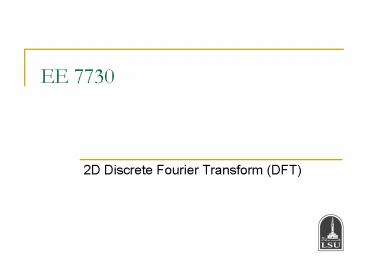EE 7730 - PowerPoint PPT Presentation
Title:
EE 7730
Description:
EE 7730. 2D Discrete Fourier Transform (DFT) Bahadir K. Gunturk. EE 7730 ... Dfg = fft (Conv_f_g,4); figure; plot(abs(Dfg)); Df1 = fft (f,3); Dg1 = fft (g,3) ... – PowerPoint PPT presentation
Number of Views:29
Avg rating:3.0/5.0
Title: EE 7730
1
EE 7730
- 2D Discrete Fourier Transform (DFT)
2
2D Discrete Fourier Transform
- 2D Fourier Transform
- 2D Discrete Fourier Transform (DFT)
2D DFT is a sampled version of 2D FT.
3
2D Discrete Fourier Transform
- 2D Discrete Fourier Transform (DFT)
where and
- Inverse DFT
4
2D Discrete Fourier Transform
- It is also possible to define DFT as follows
where and
- Inverse DFT
5
2D Discrete Fourier Transform
- Or, as follows
where and
- Inverse DFT
6
2D Discrete Fourier Transform
7
2D Discrete Fourier Transform
8
2D Discrete Fourier Transform
9
2D Discrete Fourier Transform
10
Periodicity
- M,N point DFT is periodic with period M,N
1
11
Periodicity
- M,N point DFT is periodic with period M,N
1
12
Convolution
- Be careful about the convolution property!
LengthPQ-1
LengthQ
LengthP
For the convolution property to hold, M must be
greater than or equal to PQ-1.
13
Convolution
- Zero padding
4-point DFT (M4)
14
DFT in MATLAB
- Let f be a 2D image with dimension M,N, then
its 2D DFT can be computed as follows - Df fft2(f,M,N)
- fft2 puts the zero-frequency component at the
top-left corner. - fftshift shifts the zero-frequency component to
the center. (Useful for visualization.) - Example
- f imread(saturn.tif) f double(f)
- Df fft2(f,size(f,1), size(f,2))
- figure imshow(log(abs(Df)), )
- Df2 fftshift(Df)
- figure imshow(log(abs(Df2)), )
15
DFT in MATLAB
f
Df fft2(f)
After fftshift
16
DFT in MATLAB
- Lets test convolution property
- f 1 1
- g 2 2 2
- Conv_f_g conv2(f,g) figure plot(Conv_f_g)
- Dfg fft (Conv_f_g,4) figure plot(abs(Dfg))
- Df1 fft (f,3)
- Dg1 fft (g,3)
- Dfg1 Df1.Dg1 figure plot(abs(Dfg1))
- Df2 fft (f,4)
- Dg2 fft (g,4)
- Dfg2 Df2.Dg2 figure plot(abs(Dfg2))
- Inv_Dfg2 ifft(Dfg2,4)
- figure plot(Inv_Dfg2)
17
DFT in MATLAB
- Increasing the DFT size
- f 1 1
- g 2 2 2
- Df1 fft (f,4)
- Dg1 fft (g,4)
- Dfg1 Df1.Dg1 figure plot(abs(Dfg1))
- Df2 fft (f,20)
- Dg2 fft (g,20)
- Dfg2 Df2.Dg2 figure plot(abs(Dfg2))
- Df3 fft (f,100)
- Dg3 fft (g,100)
- Dfg3 Df3.Dg3 figure plot(abs(Dfg3))
18
DFT in MATLAB
- Scale axis and use fftshift
- f 1 1
- g 2 2 2
- Df1 fft (f,100)
- Dg1 fft (g,100)
- Dfg1 Df1.Dg1
- t linspace(0,1,length(Dfg1))
- figure plot(t, abs(Dfg1))
- Dfg1_shifted fftshift(Dfg1)
- t2 linspace(-0.5, 0.5, length(Dfg1_shifted))
- figure plot(t, abs(Dfg1_shifted))
19
Example
20
Example
21
DFT-Domain Filtering
- a imread(cameraman.tif')
- Da fft2(a)
- Da fftshift(Da)
- figure imshow(log(abs(Da)),)
- H zeros(256,256)
- H(128-2012820,128-2012820) 1
- figure imshow(H,)
- Db Da.H
- Db fftshift(Db)
- b real(ifft2(Db))
- figure imshow(b,)
H
Frequency domain
Spatial domain
22
Low-Pass Filtering
81x81
61x61
121x121
23
Low-Pass Filtering
h
DFT(h)
24
High-Pass Filtering
h
DFT(h)
25
High-Pass Filtering
High-pass filter
26
Anti-Aliasing
aimread(barbara.tif)
27
Anti-Aliasing
aimread(barbara.tif) bimresize(a,0.25) cimr
esize(b,4)
28
Anti-Aliasing
aimread(barbara.tif) bimresize(a,0.25) cimr
esize(b,4) Hzeros(512,512) H(256-6425664,
256-6425664)1 Dafft2(a) Dafftshift(Da) Dd
Da.H Ddfftshift(Dd) dreal(ifft2(Dd))
29
Noise Removal
- For natural images, the energy is concentrated
mostly in the low-frequency components.
Einstein
DFT of Einstein
Profile along the red line
Signal vs Noise
Noise40rand(256,256)
30
Noise Removal
- At high-frequencies, noise power is comparable to
the signal power.
Signal vs Noise
- Low-pass filtering increases signal to noise
ratio.
31
Appendix
32
Appendix Impulse Train
- The Fourier Transform of a comb function is
33
Impulse Train (contd)
- The Fourier Transform of a comb function is
(Fourier Trans. of 1)
?
34
Impulse Train (contd)
- Proof
35
Appendix Downsampling
- Question What is the Fourier Transform of
?
36
Downsampling
- Let
Using the multiplication property
37
Downsampling
where
38
Example
39
Example
?
40
Downsampling
41
Example
42
Example
No aliasing if































